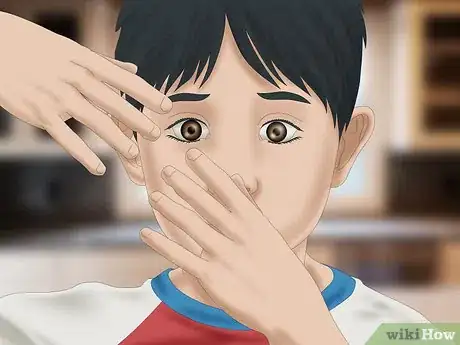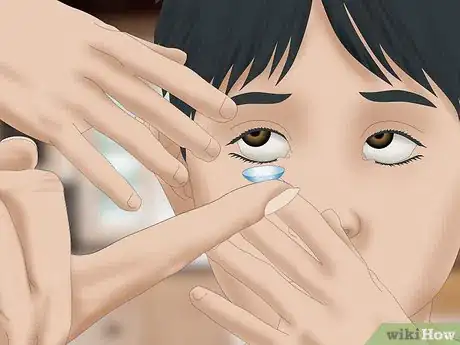This article was co-authored by Laura Marusinec, MD. Dr. Marusinec is a board certified Pediatrician at the Children's Hospital of Wisconsin, where she is on the Clinical Practice Council. She received her M.D. from the Medical College of Wisconsin School of Medicine in 1995 and completed her residency at the Medical College of Wisconsin in Pediatrics in 1998. She is a member of the American Medical Writers Association and the Society for Pediatric Urgent Care.
This article has been viewed 43,595 times.
Your child's vision needs are very important. At some point, you and your child might decide that glasses are not the best fit for your child's life; if that is the case, then you will want to discuss using contact lenses with your optometrist. But once your child comes home with his new contact lenses, he may need a little assistance. Although the thought of putting lenses into your child's eyes might seem daunting, you can easily do it with a little practice and patience.
Steps
Inserting Your Child's Contact Lenses
-
1Wash your hands with soap and warm water and dry them thoroughly. If you are using a towel, make sure that you do not have any fibers from the towel on the index finger you are using to insert the contact lens.[1]
- Avoid drying your hands with paper towels, as these tend to leave more fibers on your finger.
-
2Position your child so she is facing you. With her head tilted slightly back, ask her to look forward and then slightly upward. Try not to hover immediately above her eyes; this might cause her to instinctively blink more. Instead, place her shoulder against your side, so she is standing next to you, as opposed to in front of you.Advertisement
-
3Place the contact lens so it is curved like a bowl on the tip of your index finger. This will ensure that the contact lens is not inside out. Make sure that the lens you have on your finger corresponds to the correct eye. It is likely that your child may need a different prescription strength in each eye, so make sure you have selected the correct lens for each eye.
- Many contact lens cases will have a label for each eye; for example, the case for the right eye's lens might read "R" on the lid.
-
4Ask your child to open his eye as wide as possible. Your child will probably need to gently pull up the skin of his upper eyelid toward his eyebrow using his index finger in order to keep his eye open for the insertion. The bottom eyelid may also need to be pulled gently down, toward the cheek.
-
5Gently place the contact lens onto your child's open eye as your child is looking upward. The lens should stick to the eye almost like a suction cup once it comes in contact with it. Try to center the lens over the iris of the eye.
- As you approach the eye, ask your child not to focus on the lens itself as this will increase her risk of blinking before you can properly insert it. Instead, encourage her to look just to the right of your finger, but while still looking upward.
- Make sure the lens is well-lubricated with solution so it is not too dry. If the lens is too dry, it might not come easily off your finger as you try to insert it.
-
6Ask your child to take one slow blink. This will help the lens adjust to the curve of the eye. He may need to blink a few additional times to fit the lens. Be sure he does not blink too rapidly because this may cause the lens to fall out.
-
7Repeat these steps for the other eye.
Caring for Your Child's Contacts
-
1Help your child insert her lenses only on a temporary basis. It is important that your child learn how to insert her lenses for herself. Many optometrists will request that your child practice inserting a trial pair of contacts at their office. If your child inserts her contact lenses herself, this will also reduce her desire to blink during the application process.
- A recent study found that children between the ages of eight and nine were all successfully able to insert their own contact lenses.[2]
-
2Monitor your child's cleaning habits for his contacts. Make sure your child knows that he should never clean his contacts with water or saliva; instead, he should only use solutions and disinfectants that have been recommended by his optometrist. He must also properly store his contact lenses in an optometrist-approved solution overnight or when not in use.[3]
-
3Watch your child's wearing habits. If your child is wearing daily disposable contacts, make sure that she is properly disposing of the pair each evening and not wearing them over a longer period of time. You should ensure that your child is not sleeping in a pair of contact lenses unless the contacts have been approved for overnight use.
-
4Discuss the proper methods of contact lens insertion with your child. If your daughter is wearing make up, make sure she knows that she must insert her contact lenses prior to applying cosmetics. You should also look into using hypoallergenic cosmetic and skincare products for your child when she wears contact lenses.
Deciding if Contacts are Right for Your Child
-
1Consider your child's lifestyle. Is your child very active? Does he participate in many sports or group activities that can be impeded by glasses? Is he worried about breaking her glasses when she is active? 36% of optometrists say that parents request contacts for their children so they can more fully participate in sports.
- Contacts can also help improve your child's peripheral vision when he participates in sports.
-
2Evaluate your child's self-esteem. Do glasses negatively impact your child's self-esteem? Does she have poor self-image because she believes her glasses make her look weird or different? Recent studies have indicated that wearing contact lenses can significantly improve a child's self-esteem and her comfort in participating in group activities.[4]
-
3Consider your child's habits. Is your child good at following instructions and carrying out daily chores? Does he make his bed and keep his personal space tidy on a regular basis? If he is responsible and mature, then he will be a good candidate to take care of his contact lenses.[5]
-
4Discuss getting contacts for your child with your optometrist. Doctors will most often prescribe contact lenses for children between the ages of 10–12. These are often prescribed in conjunction with a pair of prescription glasses; at this age, contacts often serve as a secondary form of vision correction. Approximately 12% of doctors will prescribe contacts for children between the ages of eight and nine and a further 12% will prescribe contact lenses for children younger than eight years old.
- For children, doctors will often prescribe daily disposable contact lenses to minimize the risk of unhygienic storage and handling. Daily disposable lenses typically cost $100 more than longer wear lenses.
- In rare cases, optometrists will prescribe contacts for infants suffering from congenital cataracts.
- If your child suffers from seasonal allergies, then she might not be the best candidate for contacts as the lenses may cause additional irritation in the eyes.[6]
References
- ↑ https://www.fda.gov/consumers/consumer-updates/what-know-if-your-child-wants-contact-lenses
- ↑ http://www.allaboutvision.com/contacts/faq/hard-to-insert.htm
- ↑ http://www.fda.gov/ForConsumers/ConsumerUpdates/ucm318020.htm
- ↑ http://www.allaboutvision.com/parents/contacts.htm
- ↑ http://www.webmd.com/eye-health/whats-right-age-children-get-contact-lenses
- ↑ http://www.fda.gov/ForConsumers/ConsumerUpdates/ucm318020.htm










































































